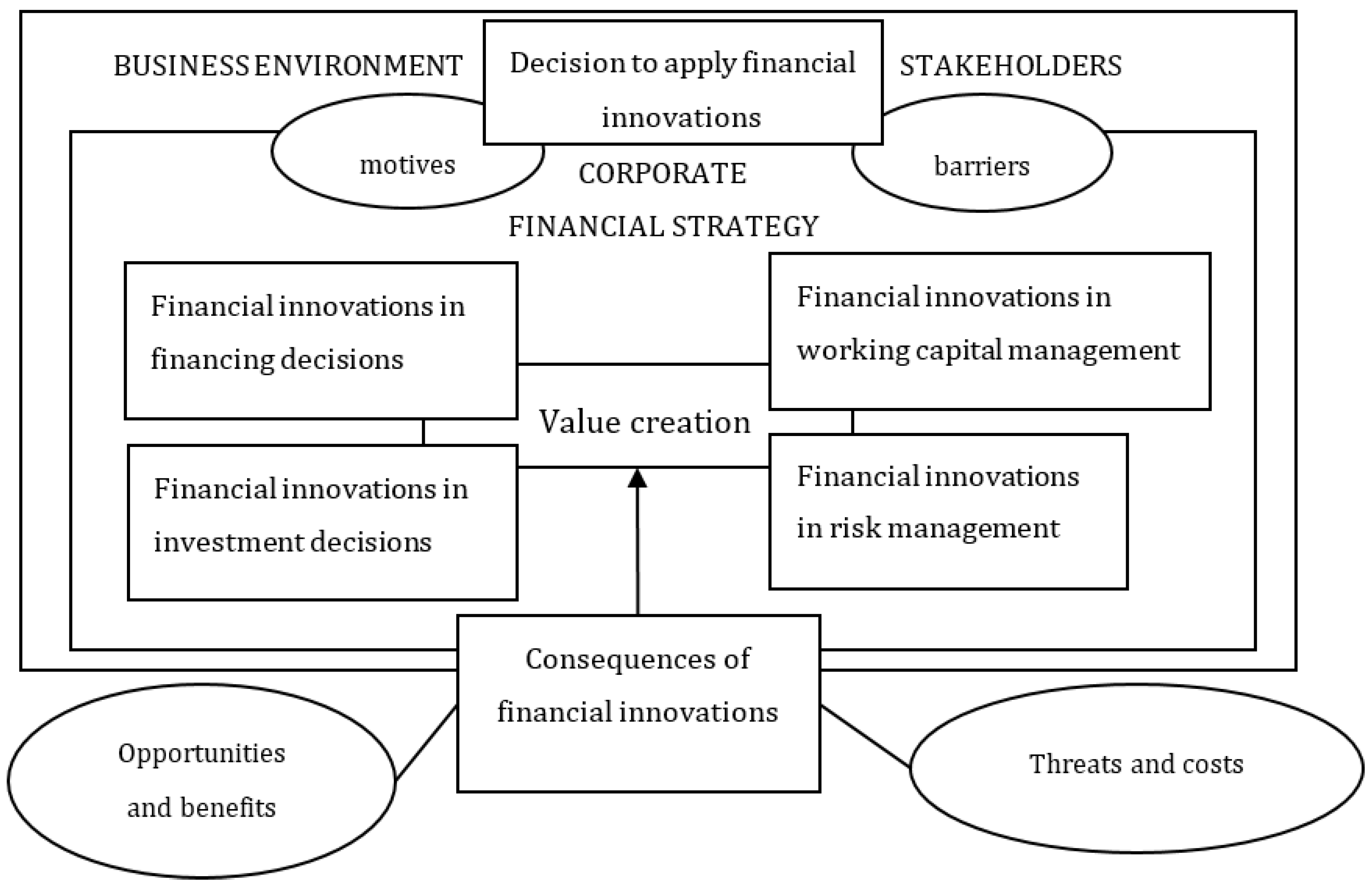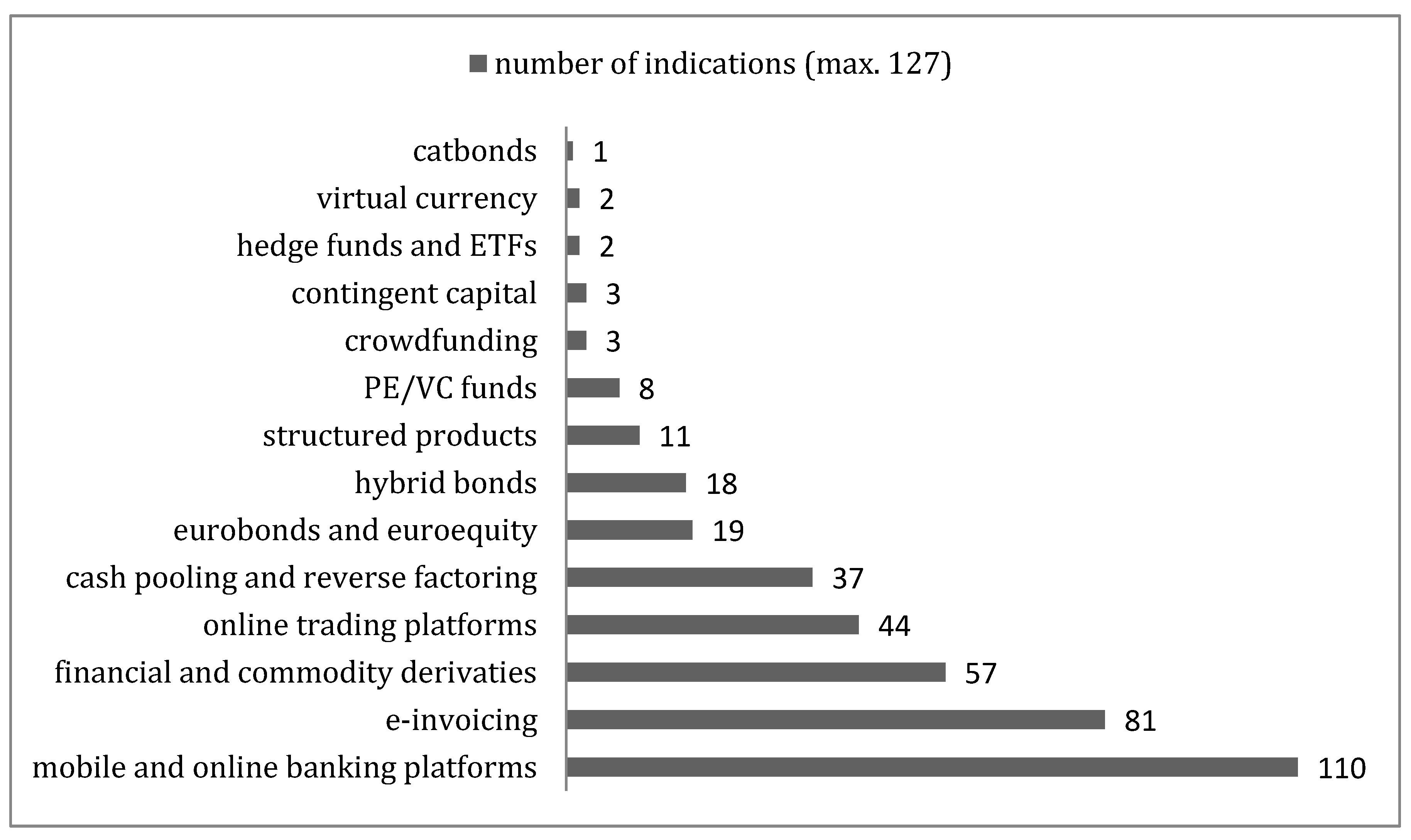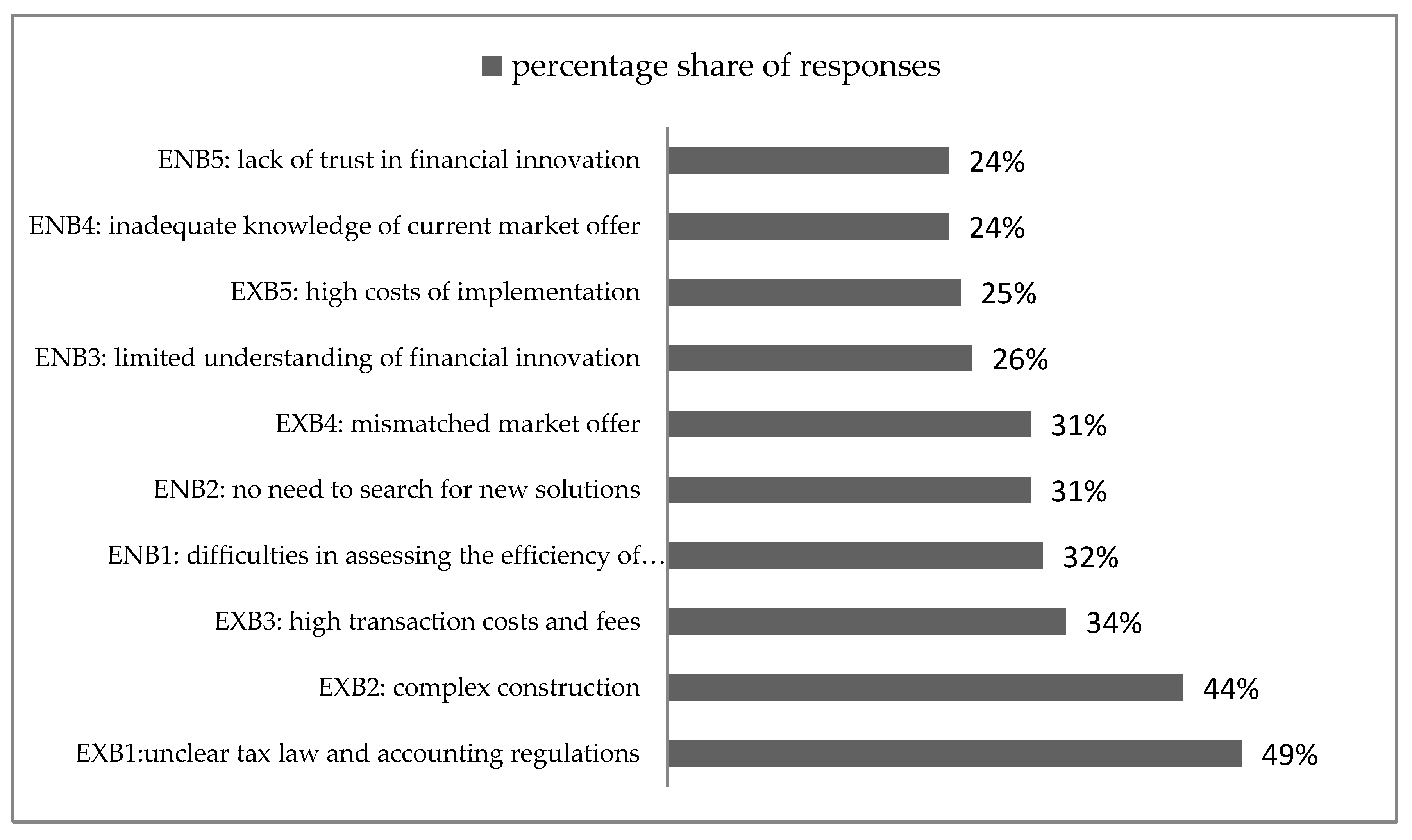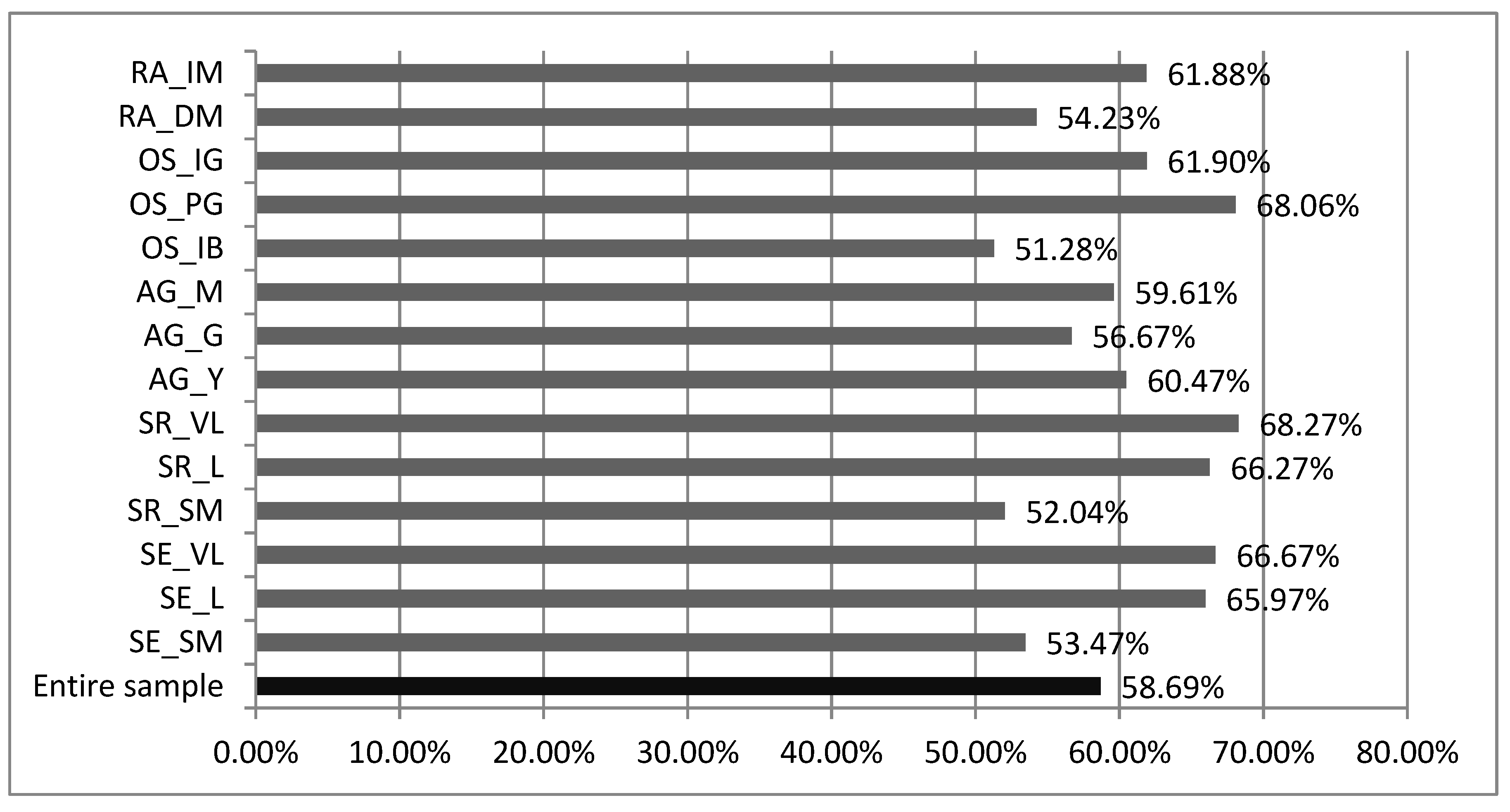Barriers to Financial Innovation—Corporate Finance Perspective
Abstract
1. Introduction
- RQ 1:
- What are the main types of barriers to financial innovations in the opinion of the financial managers?
- RQ 2:
- Is there a link between the dominant type of barriers pointed to by the managers and the firm characteristics (size, age, organization structure, range of activity)?
- RQ 3:
- What are the main types of barriers to financial innovations in the opinion of experts?
- RQ 4:
- Which factors may stimulate the application of financial innovations in the opinion of experts?
2. Literature Review
2.1. Financial Innovation as a Special Type of Innovation
2.2. Application of Financial Innovations in the Corporate Financial Strategy
2.3. Barriers to Financial Innovations Implementation in the Corporate Financial Strategy
- financial barriers (e.g., high costs of innovative activity, lack of sources of financing, transaction costs and fees),
- knowledge barriers (e.g., lack of knowledge on financial innovation, lack of qualified employees),
- market barriers (e.g., lack of information on the market offer of financial innovation, lack of matching offer),
- institutional regulations (e.g., tax and accounting regulations),
- psychological factors (e.g., lack of need to create innovations, negative attitude toward innovative processes).
3. Materials and Methods
3.1. Research Design
3.2. Structure of the Research Sample
4. Results and Discussion
4.1. Types of the Applied Financial Innovations
4.2. The Main Types of Barriers to Financial Innovations—Firms’ Perspective
4.3. The Main Types of Barriers to Financial Innovations—Experts’ Opinion
- (1)
- lack of proper sources of information, as well as lack of an adequate promotional campaign on financial innovations, leads to a knowledge gap on the potential application of financial innovation, which results in limited trust related to the reluctance of firms to use unknown solutions;
- (2)
- unclear legal regulations are connected with the fear of the negative consequences, resulting from the application of financial innovations, which combined with the reluctance to take risks, results in a preference for well-known, traditional solutions.
5. Conclusions
Funding
Conflicts of Interest
Appendix A
| List 5 financial motives for the application of financial innovations in your company |
| List 5 non-financial motives for the application of financial innovations in your company |
| List 5 main effects of the application of financial innovations in your company |
What are the effects of the application of financial innovations in your company (past experience)?
|
Are you planning to use financial innovations in your company in future (future plans)?
|
Indicate the types of financial innovations applied in your company (now or/and in the past):
|
Indicate 6 the most important barriers to the application of financial innovations in your company:
|
| Part I | Very low | Low | Moderate | High | Very high |
| In your opinion what is the level of knowledge about financial innovations in Polish firms? | |||||
| In your opinion what is the level of interest in financial innovations in Polish firms? | |||||
| In your opinion what is the level of access to financial innovations by Polish firms? | |||||
In your opinion what is the level of application of financial innovations in Polish firms:
| |||||
In your opinion what is the level of access to financial innovations by Polish firms?
| |||||
In your opinion what is the relative importance (strength) of the factors stimulating the application of financial innovations in Polish firms?
| |||||
| Part II | |||||
| List 3 crucial factors hampering the effective application of financial innovations by Polish firms | |||||
References
- Ahlers, Gerrit K. C., Douglas Cumming, Christina Günther, and Denis Schweizer. 2015. Signaling in equity crowdfunding. Entrepreneurship Theory and Practice 39: 955–80. [Google Scholar] [CrossRef]
- Allen, Franklin. 2012. Trends in Financial Innovation and their Welfare Impact: An Overview. European Financial Management 18: 493–14. [Google Scholar] [CrossRef]
- Allen, Franklin, and Glenn Yago. 2010. Financing the Future. Market-Based Innovations for Growth. Upper Saddle River: Wharton School Publishing. [Google Scholar]
- Amenc, Noël, Lionel Martellini, and Mathieu Vaissié. 2003. Benefits and risks of alternative investment strategies. Journal of Asset Management 4: 96–118. [Google Scholar] [CrossRef]
- Anderloni, Luisa, and Paola Bongini. 2009. Is Financial Innovation Still a Relevant Issue? In Financial Innovation in Retail and Corporate Banking. Edited by Luisa Anderloni, David T. Llewellyn and Reinhard H. Schmidt. Cheltenham: Edward Elgar. [Google Scholar]
- Assink, Marnix. 2006. Inhibitors of disruptive innovation capability: A conceptual model. European Journal of Innovation Management 9: 215–33. [Google Scholar] [CrossRef]
- Awrey, Dan. 2013. Toward a supply-side theory of financial innovation. Journal of Comparative Economics 41: 401–19. [Google Scholar] [CrossRef]
- Baregheh, Anahita, Jennifer Rowley, and Sally Sambrook. 2009. Towards a multidisciplinary definition of innovation. Management Decision 47: 1323–39. [Google Scholar] [CrossRef]
- Beck, Thorsten, Tao Chen, Chen Lin, and Frank M. Song. 2016. Financial Innovation: The bright and the dark sides. Journal of Banking and Finance 72: 28–51. [Google Scholar] [CrossRef]
- Błach, Joanna. 2011. Financial innovations and their role in the modern financial system-identification and systematization of the problem. e-Finanse: Financial Internet Quarterly 7: 13–26. [Google Scholar]
- Błach, Joanna. 2018. Innowacje finansowe w przedsiębiorstwie. Warszawa: C.H. Beck. [Google Scholar]
- Boer, Harry, and Willem E. During. 2001. Innovation, what innovation? A comparison between product, process and organizational innovation. International Journal of Technology Management 22: 83–107. [Google Scholar] [CrossRef]
- Bogers, Marcel, Allan Afuah, and Bettina Bastian. 2010. Users as Innovators: A Review, Critique, and Future Research Directions. Journal of Management 36: 857–75. [Google Scholar] [CrossRef]
- Bolton, Patrick, and Frederic Samama. 2012. Capital access bonds: Contingent capital with an option to convert. Economic Policy 27: 275–317. [Google Scholar] [CrossRef]
- Bouriaux, Sylvie, and Richard MacMinn. 2009. Securitization of catastrophe risk: New developments in insurance-linked securities and derivatives. Journal of Insurance Issues 32: 1–34. [Google Scholar]
- Boz, Emine, and Enrique G. Mendoza. 2014. Financial innovation, the discovery of risk and the U.S. credit crisis. Journal of Monetary Economics 62: 1–22. [Google Scholar] [CrossRef]
- Campbell, Rachel. 2008. Art as a financial investment. The Journal of Alternative Investments 10: 64–81. [Google Scholar] [CrossRef]
- Chen, Mark A., Qinxi Wu, and Baozhong Yang. 2019. How valuable is FinTech innovation? The Review of Financial Studies 32: 2062–106. [Google Scholar] [CrossRef]
- Chesbrough, Henry W. 2006. The era of open innovation. Managing Innovation and Change 127: 34–41. [Google Scholar]
- Chesbrough, Henry, and Marcel Bogers. 2014. Explicating open innovation: Clarifying an emerging paradigm for understanding innovation. In New Frontiers in Open Innovation. Oxford: Oxford University Press. [Google Scholar] [CrossRef]
- Cocco, Joao F., and Francisco J. Gomes. 2012. Longevity risk, retirement savings, and financial innovation. Journal of Financial Economics 103: 507–29. [Google Scholar] [CrossRef]
- Coval, Joshua, Jakub Jurek, and Erik Stafford. 2009. The Economics of Structured Finance. Journal of Economic Perspectives 23: 3–25. [Google Scholar] [CrossRef]
- Culp, Christopher L. 2002. Contingent capital: Integrating corporate financing and risk management decisions. Journal of Applied Corporate Finance 15: 46–56. [Google Scholar] [CrossRef]
- Cummins, J. David, Richard D. Phillips, and Stephen D. Smith. 2001. Derivatives and corporate risk management: Participation and volume decisions in the insurance industry. Journal of Risk and Insurance, 51–91. [Google Scholar] [CrossRef]
- Dabic, Marina, Vladimir Cvijanovic, and Miguel González-Loureiro. 2011. Keynesian, Post-Keynesian Versus Schumpeterian, Neo-Schumpeterian. An Integrated Approach to the Innovation Theory. Management Decision 49: 195–207. [Google Scholar] [CrossRef]
- Dahlander, Linus, Lars Frederiksen, and Francesco Rullani. 2008. Online Communities and Open Innovation. Industry and Innovation 15: 115–23. [Google Scholar] [CrossRef]
- Den Haan, Wouter J., and Vincent Sterk. 2011. The Myth of Financial Innovation and the Great Moderation. The Economic Journal 121: 707–39. [Google Scholar] [CrossRef]
- Di Stefano, Giada, Alfonso Gambardella, and Gianmario Verona. 2012. Technology push and demand pull perspectives in innovation studies: Current findings and future research directions. Research Policy 41: 1283–95. [Google Scholar] [CrossRef]
- Drew, Stephen A. W. 1995. Accelerating innovation in financial services. Long Range Planning 28: 1–21. [Google Scholar] [CrossRef]
- Drucker, Peter F. 2002. The Discipline of Innovation. Harvard Business Review 80: 95–104. [Google Scholar] [CrossRef]
- Eichholtz, Piet, and Erkan Yönder. 2015. CEO overconfidence, REIT investment activity and performance. Real Estate Economics 43: 139–62. [Google Scholar] [CrossRef]
- Evstigneev, I., T. Hens, and K. Reiner Shenk-Hope. 2004. Reiner Shenk-Hope. Evolutionary Finance (National Center Competence Research Financial Valuation and Risk Management Working Paper No. 462). Zurich: National Center of Competence Research. [Google Scholar]
- Fabozzi, Frank J., Franco Modigliani, and Frank J. Jones. 2003. Capital Markets. Institutions and Instruments. Upper Saddle River: Pearson Education International. [Google Scholar]
- Finnerty, John D. 1988. Financial Engineering in Corporate Finance: Overview. Financial Management 17: 14–33. [Google Scholar] [CrossRef]
- Frączek, Bożena, and Monika Klimontowicz. 2015. Financial literacy and its influence on Young customers’ decision factors. Journal of Innovation Management 3: 62–84. [Google Scholar] [CrossRef]
- Frame, W. Scott, and Lawrence J. White. 2014. Technological Change, Financial Innovation, and Diffusion in Banking. NYU Working Paper 2451/33549. New York: Leonard N. Stern School of Business, Department of Economics. [Google Scholar] [CrossRef]
- Gai, Prasanna, Sujit Kapadia, Stephen Millard, and Ander Perez. 2008. Financial innovation, macroeconomic stability and systemic crises. The Economic Journal 118: 401–26. [Google Scholar] [CrossRef]
- Gołębiowski, Tomasz, and Małgorzata Stefania Lewandowska. 2015. Influence of internal and external relationships of foreign subsidiaries on innovation performance. Evidence from Germany, Czech Republic and Romania. JEEMS Journal of East European Studies 20: 304–27. [Google Scholar] [CrossRef]
- Götze, Tobias, and Marc Gürtler. 2019. Hard markets, hard times: On the inefficiency of the CAT bond market. Journal of Corporate Finance 62: 101553. [Google Scholar] [CrossRef]
- Guest, Greg, Arwen Bunce, and Laura Johnson. 2006. How many interviews are enough? An experiment with data saturation and variability. Field Methods 18: 59–82. [Google Scholar] [CrossRef]
- Gupta, Sunil. 2013. The mobile banking and payment revolution. European Financial Review 2: 215254. [Google Scholar]
- Gurkov, Igor. 2005. Innovations in Russian industries: Conditions for implementation and impact on competitiveness. JEEMS Journal of East European Management Studies 10: 218–46. [Google Scholar] [CrossRef]
- Gustman, Alan L., Thomas L. Steinmeier, and Nahid Tabatabai. 2012. Financial knowledge and financial literacy at the household level. American Economic Review 102: 309–13. [Google Scholar] [CrossRef]
- Harasim, Janina, and Monika Klimontowicz. 2013. Payment Habits as a Determinant of Retail Payment Innovations Diffusion: The Case of Poland. Journal of Innovation Management 1: 86–102. [Google Scholar] [CrossRef]
- Henderson, Brian J., and Neil D. Pearson. 2009. The Dark Side of Financial Innovation. EFA 2009 Bergen Meetings Paper. [Google Scholar] [CrossRef]
- Hueske, Anne-Karen, and Edeltraud Guenther. 2015. What hampers innovation? External stakeholders, the organization, groups and individuals: A systematic review of empirical barrier research. Management Review Quarterly 65: 113–48. [Google Scholar] [CrossRef]
- Jenkinson, Nigel, Adrian Penalver, and Nicholas Vause. 2008. Financial Innovation: What Have We Learnt? Bank of England, Quarterly Bulletin 3: 330–38. [Google Scholar]
- Kapoor, Rahul, and Anne-Laure Mention. 2015. Patenting financial innovation in Europe. Paper presented at 2015 Portland International Conference on Management of Engineering and Technology (PICMET), Portland, OR, USA, August 2–6. [Google Scholar]
- Kieżel, Ewa, and Sławomir Smyczek. 2015. Analfabetyzm finansowy jako bariera w akceptacji innowacji na rynku usług finansowych. Marketing i Rynek 2: 132–41. [Google Scholar]
- Klimontowicz, Monika. 2019. The Role of Banks’ Innovativeness in Building Sustainable Efficiency: The Case of Poland. Entrepreneurship and Sustainability 7: 525–39. [Google Scholar] [CrossRef]
- Klimontowicz, Monika, and Janina Harasim. 2019. The determinants of banks’ innovativeness. In International Conference on Innovation and Entrepreneurship. Sonning Common: Academic Conferences International Limited, p. 530. [Google Scholar]
- Laeven, Luc, Ross Levine, and Stelios Michalopoulos. 2015. Financial innovation and endogenous growth. Journal of Financial Intermediation 24: 1–24. [Google Scholar] [CrossRef]
- Lebelle, Martin, Souad Lajili Jarjir, and Syrine Sassi. 2020. Corporate Green Bonds Issuances: An International Evidence. Journal of Risk and Financial Management 13: 25. [Google Scholar] [CrossRef]
- Lerner, Josh. 2006. The New Financial Thing: The Origins of Financial Innovations. Journal of Financial Economics 79: 223–55. [Google Scholar] [CrossRef]
- Lerner, Josh, Amit Seru, Nicholas Short, and Yuan Sun. 2020. Financial Innovation in the 21st Century: Evidence from US Patenting. Working Paper. Available online: https://scholar.harvard.edu/files/nickshort/files/financialinnovation21stcentury.20200730.pdf (accessed on 31 October 2020).
- Lerner, Josh, and Peter Tufano. 2011. The Consequences of Financial Innovation: A Counterfactual Research Agenda. Working Paper 16780. Cambridge: National Bureau of Economic Research. [Google Scholar] [CrossRef]
- Lievens, Annouk, Rudy K. Moenaert, and Rosette S. Jegers. 1999. Linking Communication to Innovation Success in the Financial Services Industry: A Case Study Analysis. International Journal of Service Industry Management 10: 23–47. [Google Scholar] [CrossRef]
- Llewellyn, David T. 2009. Financial Innovation and the Economics of Banking and the Financial System. In Financial Innovation in Retail and Corporate Banking. Edited by Luisa Anderloni and David T. Llewellyn. Cheltenham: Edward Elgar. [Google Scholar]
- Lorenz, Edward, and Sophie Pommet. 2020. Mobile money, inclusive finance and enterprise innovativeness: An analysis of East African nations. Industry and Innovation. [Google Scholar] [CrossRef]
- Lumpkin, Stephen. 2010. Regulatory Issues Related to Financial Innovation. OECD Journal: Financial Market Trends 2. [Google Scholar] [CrossRef]
- Madeira, Maria José, João Carvalho, Jacinta Moreira, Filipe A. P. Duarte, and Flávio de São Pedro Filho. 2017. Barriers to innovation and the innovative performance of Portuguese firms. Journal of Business 9: 2–22. [Google Scholar] [CrossRef][Green Version]
- Marcinkowska, Monika. 2012. Innowacje finansowe w bankach. Acta Universitatis Lodziensis, Folia Oeconomica 266: 71–96. [Google Scholar]
- Merton, Robert C. 1995. Financial innovation and the management and regulation of financial institutions. Journal of Banking & Finance 19: 461–81. [Google Scholar] [CrossRef]
- Michalopoulos, Stelios, Luc Laeven, and Ross Levine. 2009. Financial Innovation and Endogenous Growth. Working Paper 15356. Cambridge: National Bureau of Economic Research. [Google Scholar] [CrossRef]
- Mikl-Horke, Gertraude. 2004. Globalization, transformation and the diffusion of management innovations. JEEMS Journal of East European Management Studies 9: 98–122. [Google Scholar] [CrossRef]
- Miller, Merton H. 1986. Financial Innovation: The Last Twenty Years and the Next. Journal of Financial and Quantitative Analysis 21: 459–71. [Google Scholar] [CrossRef]
- Molyneux, P., and N. Shamroukh. 1999. Financial Innovation. Chichester: Wiley. [Google Scholar]
- Moskal, Agnieszka, and Danuta Zawadzka. 2014. Investment in gold as an example of alternative investment-in the context of capital market in Poland. Ekonomia i Zarządzanie 6: 330–43. [Google Scholar]
- Mucelli, Attilio, Anna Alon, Cristiano Venturini, and Dominique Lepore. 2020. Cash pooling: An organizational response to institutional complexity. Journal of Transnational Management, 1–15. [Google Scholar] [CrossRef]
- Nesvetailova, Anastasia. 2014. Innovations, fragility and complexity: Understanding the power of finance. Government and Opposition 49: 542–68. [Google Scholar] [CrossRef]
- Nicoletti, B. 2017. Fintech Innovation. In The Future of FinTech. Cham: Palgrave Macmillan, pp. 81–159. [Google Scholar]
- Persons, John C., and Vincent A. Warther. 1997. Boom and Bust Patterns in the Adoption of Financial Innovations. Review of Financial Studies. [Google Scholar] [CrossRef]
- Piller, Frank, and Joel West. 2014. Firms, Users, and Innovation: An Interactive Model of Coupled Open Innovation. In New Frontiers in Open Innovation. Edited by Henry William Chesbrough, Wim Vanhaverbeke and Joel West. Oxford: Oxford University Press, pp. 29–49. [Google Scholar] [CrossRef]
- Polasik, Michal, and Piotr Fiszeder. 2010. Factors Determining the Acceptance of Payment Methods by Online Shops in Poland. Available online: https://papers.ssrn.com/sol3/papers.cfm?abstract_id=1541202 (accessed on 30 October 2020). [CrossRef]
- Polasik, Michal, and Tomasz Piotr Wiśniewski. 2009. Empirical analysis of Internet banking adoption in Poland. International Journal of Bank Marketing 27: 32–52. [Google Scholar] [CrossRef]
- Poterba, James M., and John B. Shoven. 2002. Exchange-traded funds: A new investment option for taxable investors. American Economic Review 92: 422–27. [Google Scholar] [CrossRef]
- Pyka, Irena. 2013. Produktowe innowacje banków komercyjnych. Analiza przyczynowo-skutkowa. Studia Ekonomiczne 173: 253–67. [Google Scholar]
- Redmond, William. 2013. Financial Innovation, Diffusion, and Instability. Journal of Economic Issues 47: 525–32. [Google Scholar] [CrossRef]
- Rogers, Everett M. 1995. Lessons for guidelines from the diffusion of innovations. The Joint Commission Journal on Quality Improvement 21: 324–28. [Google Scholar] [CrossRef]
- Rossignoli, Bruno, and Francesca Arnaboldi. 2009. Financial innovation: Theoretical issues and empirical evidence in Italy and in the UK. International Review of Economics 56: 275–301. [Google Scholar] [CrossRef]
- Saksonova, Svetlana, and Irina Kuzmina-Merlino. 2017. Fintech as financial innovation—The possibilities and problems of implementation. European Research Studies Journal 20: 961–73. [Google Scholar] [CrossRef]
- Santoro, Gabriele, Alberto Ferraris, Elisa Giacosa, and Guido Giovando. 2018. How SMEs Engage in Open Innovation: A Survey. Journal of Knowledge Economy 9: 561–74. [Google Scholar] [CrossRef]
- Shiller, Robert J. 2013. Capitalism and Financial Innovation. Financial Analysts Journal 69: 21–25. [Google Scholar] [CrossRef]
- Sieradzka, Katarzyna. 2020. Crowdfunding as a Source for Start-up Financing in Poland. Zeszyty Naukowe, 247–58. [Google Scholar]
- Silber, William L. 1983. The process of financial innovation. The American Economic Review 73: 89–95. [Google Scholar]
- Skuras, Dimitris, Kyriaki Tsegenidi, and Kostas Tsekouras. 2008. Product innovation and the decision to invest in fixed capital assets: Evidence from an SME survey in six European Union member states. Research Policy 37: 1778–89. [Google Scholar] [CrossRef]
- Spence, W. R. 1994. Innovation. The Communication of Change in Ideas, Practice and Products. London: Chapman and Hall. [Google Scholar]
- Stradomski, Maciej. 2006. Innowacje Finansowe w Kreowaniu Wartości Przedsiębiorstwa. Poznań: Akademia Ekonomiczna w Poznaniu. [Google Scholar]
- Świecka, Beata, Paweł Terefenko, and Dominik Paprotny. 2020. Transaction factors’ influence on the choice of payment by Polish consumer. Journal of Retailing and Consumer Services 58: 102264. [Google Scholar] [CrossRef]
- Tang, Dragon Yongjun, and Yupu Zhang. 2020. Do shareholders benefit from green bonds? Journal of Corporate Finance 61: 101427. [Google Scholar] [CrossRef]
- Tapscott, Alex, and Don Tapscott. 2017. How blockchain is changing finance. Harvard Business Review 1: 2–5. [Google Scholar]
- Tsai, Chang-Hsien, and Kuan-Jung Peng. 2017. The fintech revolution and financial regulation: The case of online supply-chain financing. Asian Journal of Law and Society 4: 109. [Google Scholar] [CrossRef]
- Tufano, Peter. 1996. How Financial Engineering Can Advance Corporate Strategy. Harvard Business Review 74: 136–46. [Google Scholar]
- Tufano, Peter. 2003. Financial Innovation. In The Handbook of the Economics of Finance. Edited by George M. Constantinides. Amsterdam: Elsevier, vol. 1A. [Google Scholar]
- Vermeulen, Patrick. 2004. Managing product innovation in financial services firms. European Management Journal 22: 43–50. [Google Scholar] [CrossRef]
- von Krogh, Georg, Stefan Haefliger, Sebastian Spaeth, and Martin W. Wallin. 2012. Carrots and Rainbows: Motivation and Social Practice in Open Source Software Development. MIS Quarterly 36: 649–76. [Google Scholar] [CrossRef]
- Węcławski, Jerzy. 2017. Dilemmas of family businesses financing by private equity. Acta Universitatis Lodziensis. Folia Oeconomica 1: 203. [Google Scholar] [CrossRef]
- Wieczorek-Kosmala, Monika. 2020. Weather Risk Management in Energy Sector: The Polish Case. Energies 13: 945. [Google Scholar] [CrossRef]
- Zheng, Zibin, Shaoan Xie, Hong-Ning Dai, Xiangping Chen, and Huaimin Wang. 2018. Blockchain challenges and opportunities: A survey. International Journal of Web and Grid Services 14: 352–75. [Google Scholar] [CrossRef]






| Characteristics | Description | Subcategories |
|---|---|---|
| Size (SE) | Number of employees | Small—SE_SM—up till 250 |
| Large—SE_L—200–2500 | ||
| Very large—SE_VL—above 2500 | ||
| Size (SR) | Total revenues (in PLN million) | Small—SR_SM—up till 200 |
| Large—SR_L—200–500 | ||
| Very large—SR_VL—above 500 | ||
| Age (AG) | Number of years since inception | Young—AG_Y—up till 5 years of operation |
| Medium-aged—AG_G—5–15 years of operation | ||
| Mature—AG_M—above 15 years of operation | ||
| Organization structure (OS) | Form of organization structure | OS_IB—independent business organization |
| OS_PG—part of national capital group | ||
| OS_IG—part of international capital group | ||
| Range of activity (RA) | Market of operations | RA_DM—only domestic market |
| RA_IM—international market |
| Size (Employment) | Size (Revenues) | Age | Organization Structure | Range of Activity | |||||
|---|---|---|---|---|---|---|---|---|---|
| SE_SM | 59% | SR_SM | 57% | AG_Y | 17% | OS_IB | 47% | RA_DM | 41% |
| SE_L | 27% | SR_L | 13% | AG_G | 36% | OS_PG | 32% | RA_IM | 59% |
| SE_VL | 14% | SR_VL | 30% | AG_M | 47% | OS_IG | 21% | ||
| Firm Characteristics | SE | SR | AG | OS | RA |
|---|---|---|---|---|---|
| R_EXB | 0.178 ** | 0.230 * | −0.004 | 0.162 | 0.117 |
| Firm Characteristics | R_EXB |
|---|---|
| SE | 4.121; p-value 0.127 |
| SR | 6.812; p-value 0.033 ** |
| AG | 0.12; p-value 0.942 |
| OS | 6.071; p-value 0.047 ** |
| RA | 1.733; p-value 0.188 |
| Endogenous Factors (ENB) | Exogenous Factors (EXB) |
|---|---|
| Organization barriers lack of sufficient knowledge in firms about the possibilities of applying financial innovations lack of professional staff with adequate skills and knowledge of the current market offer of the financial products and services available in the financial system | Market barriers the complex construction of financial innovation difficult access to new financial services and products due to the requirements imposed on customers of financial institutions lack of good sources of information on the market offer lack of appropriate advertising from the suppliers (creators) of financial innovation mismatch of the market offer of the new financial products and services to the specificity and needs of the firms lack of competent experts, employees of financial institutions supporting companies in the selection of appropriate financial innovations |
| Psychological barriers reluctance to introduce innovation coupled with the habit and convenience of using traditional financial solutions lack of trust in the financial institutions offering innovations (both traditional and new financial service providers) fear of the risk resulting from the application of financial innovations reluctance to change | Legal barriers unclear and complicated legal regulations related to financial innovation (in this: Tax and accounting regulations) |
| Financial barriers high transaction costs and fees associated with the application of financial innovations |
Publisher’s Note: MDPI stays neutral with regard to jurisdictional claims in published maps and institutional affiliations. |
© 2020 by the author. Licensee MDPI, Basel, Switzerland. This article is an open access article distributed under the terms and conditions of the Creative Commons Attribution (CC BY) license (http://creativecommons.org/licenses/by/4.0/).
Share and Cite
Błach, J. Barriers to Financial Innovation—Corporate Finance Perspective. J. Risk Financial Manag. 2020, 13, 273. https://doi.org/10.3390/jrfm13110273
Błach J. Barriers to Financial Innovation—Corporate Finance Perspective. Journal of Risk and Financial Management. 2020; 13(11):273. https://doi.org/10.3390/jrfm13110273
Chicago/Turabian StyleBłach, Joanna. 2020. "Barriers to Financial Innovation—Corporate Finance Perspective" Journal of Risk and Financial Management 13, no. 11: 273. https://doi.org/10.3390/jrfm13110273
APA StyleBłach, J. (2020). Barriers to Financial Innovation—Corporate Finance Perspective. Journal of Risk and Financial Management, 13(11), 273. https://doi.org/10.3390/jrfm13110273





